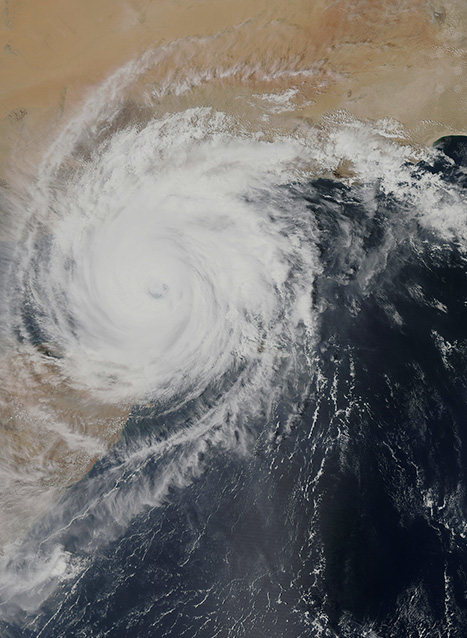
Hurricane Florence to Strike Eastern Seaboard of the US
13 Sep 2018
Hurricane Florence is the first major hurricane of the 2018 hurricane season to hit the United States. Florence is approximately 145 miles east-southeast of Wilmington, North Carolina and is expected to make landfall around midday on 14 September. Florence is moving northwest at 12mph and has a sustained wind speed of 110mph. Florence has been downgraded from a category three hurricane to a category two, however, it is not expected to weaken further before it makes landfall. At least 1.7 million people have been ordered to evacuate across South Carolina, North Carolina and Virginia, while a further 5.25 million people are under a hurricane warning.
Key Points
- Hurricane Florence is expected to make landfall on 14 September as a category two hurricane bringing sustained wind speeds of up to 110mph.
- The states of Georgia, North and South Carolina, Virginia, Maryland, and Washington DC have all declared a state of emergency.
- Some 10 million people are now under some form of storm watch, with up to 1.7 million in mandatory evacuation zones.
Situational Summary
Environmental: Hurricane Florence is the first major hurricane of the 2018 hurricane season to hit the United States. Florence is approximately 145 miles east-southeast of Wilmington, North Carolina and is expected to make landfall around midday on 14 September. Florence is moving northwest at 12mph and has a sustained wind speed of 110mph. Florence has been downgraded from a category three hurricane to a category two, however, it is not expected to weaken further before it makes landfall. At least 1.7 million people have been ordered to evacuate across South Carolina, North Carolina and Virginia, while a further 5.25 million people are under a hurricane warning.
There is a significant risk of storm surges across the regions, with surges up to 13 foot predicted between Cape Fear and Cape Lookout in North Carolina. Meteorologists believe Hurricane Florence will stall when it reaches the US east coast due to changing conditions. After travelling more than 350 miles each day this week, the storm is anticipated to move just 75 or 85 miles on 14 September. This has made predicting the hurricane’s course problematic and in turn has made forecasting unreliable, with multiple conflicting reports being distributed. Authorities are concerned that some residents will believe their property is safe to return to yet may still be in danger of further flooding.
Although Florence is not the most powerful storm to hit the region, meteorologists fear the storm is likely to stall along the south-eastern coast of United States when it makes landfall on 14 September. If Hurricane Florence does stall, it will result in a greatly increased concentration of rainfall and almost certainly result in a major flooding event. North and South Carolina may experience at least 30 inches of rain when Florence makes landfall, but that could reach 40 inches in some areas. Energy companies have warned that power disruption is highly likely in many areas affected by the storm and up to 759,000 homes and businesses are highly likely to sustain damage. In a similar storm event, Hurricane Harvey stalled as it approached Houston in 2017, resulting in a significant increase in damage. Harvey killed 88 people and displaced more than 30,000.
SECURITY ADVICE
EnvironmentHighLocal and state government have issued wide-ranging evacuation orders. Travellers within a mandatory evacuation zone should seek to comply with these instructions as an urgent priority.
Travellers are advised to pay close attention to weather updates in the coming days to see how the direction and the intensity of the storm changes. All those in the region should ensure they have a hurricane plan in place, as further storms are likely over the course of the season which lasts from 1 June to 30 November.
When this storm makes landfall, it is advisable to avoid low lying areas because of the increased chances of flooding from storm surges and heavy rain. It is also advised to cover windows with storm shutters and make any alterations to accommodation to ensure protection, such as sandbags around doorways if flooding is a concern.
If sheltering in place, food supplies should consist of non-perishable items and be enough to support each family member for at least three days. One gallon of water per day per person is also recommended. It is also advisable that families and loved ones are informed of your current position and kept regularly updated so that they can send assistance in case they lose contact with you.
Travellers who are on holiday should follow the instructions of the hotel authorities as they will have their own hurricane plans and formalities.
Travellers utilising air travel in the region over the coming week should contact their airline to understand what impact Hurricane Florence will have on their travel plans.
Solace Global recommends all travellers to the United States of America maintain a normal level of security preparedness and situational awareness throughout their trip, enhanced security measures are not required for routine travel. The use of travel-tracking technology with an intelligence feed is recommended to stay updated on travel and security-related events and allow employers to implement effective duty of care.